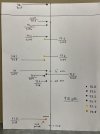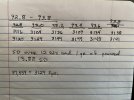I want to explain things a little more, because I think it helps when you know why your doing something. Just about every good tuning method is basically doing the same thing, the format is just different. A sine wave target like I described above for shooting 100yds, is the same thing as a ladder test. The difference is a ladder is shot at the same poi. The look totally different but you read them the same way. Your still looking for the spot the barrel harmonics slow down when they are changing directions. This is at the barrels extreme end of travel. On the sine wave target or something like the ocw method that spot will look like 3 consecutive groups (for example) with similar poi at the top or bottom of the "wave". When you shoot a ladder it will look like a group of 3 shots (or 9 shots if you shoot 3 shot groups in the ladder format like I often do) with vertical stringing above and below. Its exactly the same thing, one is just spread out on a horizontal line the other is all up and down because we shoot ladders at the same poa. I recommend the sine wave target at short range because a ladder just ends up looking like a big hole and you cant read it. In both methods we are looking at barrel harmonics and where the barrel is pointing as much as we are looking at the groups. Thats why you get vertical in a group, its when the barrel is moving quickly. Just remember its all about timing the bullets exit during the harmonic pattern of the barrel. Now the ONLY reason I prefer the ladder format at long range, is that it takes into account trajectory. The trajectory can help you or hurt you at long range depending on where your load is timed to the harmonics (search positive compensation). The other reason is the ladder format takes up much less space on the target, at 1k thats important. But you could gain the exact same information if you shot a sine wave target at 1k as the ladder, you just need to understand how to read them.





